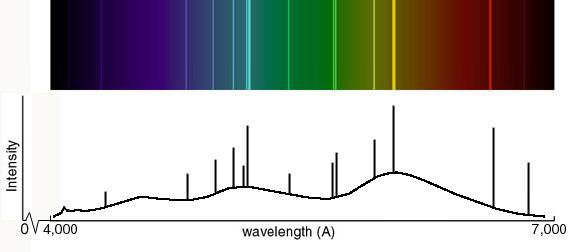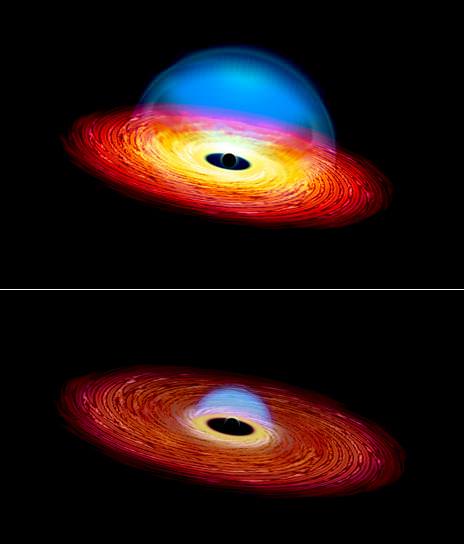Last week, astronomers at Yale University reported seeing something unusual: a seemingly stedfast beacon from the far reaches of the Universe went quiet. This relic light source, a quasar located in the region of our sky known as the celestial equator, unexpectedly became 6-7 times dimmer over the first decade of the 21st century. Thanks to this dramatic change in luminosity, astronomers now have an unprecedented opportunity to study both the life cycle of quasars and the galaxies that they once called home.
A quasar arises from a distant (and therefore, very old) galaxy that once contained a central, rotating supermassive black hole – what astronomers call an active galactic nucleus. This spinning beast ravenously swallowed up large amounts of ambient gas and dust, kicking up surrounding material and sending it streaming out of the galaxy at blistering speeds. Quasars shine because these ancient jets achieved tremendous energies, thereby giving rise to a torrent of light so powerful that astronomers are still able to detect it here on Earth, billions of years later.
In their hey-day, some active galactic nuclei were also energetic enough to excite electrons farther away from the central black hole. But even in the very early Universe, electrons couldn’t withstand that kind of excitement forever; the laws of physics don’t allow it. Eventually, each electron would drop back down to its rest state, releasing a photon of corresponding energy. This cycle of excitation happened over and over and over again, in regular and predictable patterns. Modern astronomers can visualize those transitions – and the energies that caused them – by examining a quasar’s optical spectrum for characteristic emission lines at certain wavelengths.

Not all quasars are created equal, however. While the spectra of some quasars reveal many bright, broad emission lines at different energies, other quasars’ spectra consist of only the dim, narrow variety. Until now, some astronomers thought that these variations in emission lines among quasars were simply due to differences in their orientation as seen from Earth; that is, the more face-on a quasar was relative to us, the broader the emission lines astronomers would be able to see.
But all of that has now been thrown into question, thanks to our friend J015957.64+003310.5, the quasar revealed by the team of astronomers at Yale. Indeed, it is now plausible that a quasar’s pattern of emission lines simply changes over its lifetime. After gathering ten years of spectral observations from the quasar, the researchers observed its original change in brightness in 2010. In July 2014, they confirmed that it was still just as dim, disproving hypotheses that suggested the effect was simply due to intervening gas or dust. “We’ve looked at hundreds of thousands of quasars at this point, and now we’ve found one that has switched off,” explained C. Megan Urry, the study’s co-author.
How would that happen, you ask? After observing the comparable dearth of broad emission lines in its spectrum, Urry and her colleagues believe that long ago, the black hole at the heart of the quasar simply went on a diet. After all, an active galactic nucleus that consumed less material would generate less energy, giving rise to fainter particle jets and fewer excited atoms. “The power source just went dim,” said Stephanie LaMassa, the study’s principal investigator.
LaMassa continued, “Because the life cycle of a quasar is one of the big unknowns, catching one as it changes, within a human lifetime, is amazing.” And since the life cycle of quasars is dependent on the life cycle of supermassive black holes, this discovery may help astronomers to explain how those that lie at the center of most galaxies evolve over time – including Sagittarius A*, the supermassive black hole at the center of our own Milky Way.
“Even though astronomers have been studying quasars for more than 50 years, it’s exciting that someone like me, who has studied black holes for almost a decade, can find something completely new,” added LaMassa.
The team’s research will be published in an upcoming issue of The Astrophysical Journal. A pre-print of the paper is available here.


Interesting study, indeed.
However, the second paragraph is quite misleading. First of all, you should not write about time, but better about distance! The galaxies we see at great distances (such as quasars) are not old; they are much younger than the Milky Way. Secondly, — even though I am sure you don’t mean it — you imply that a supermassive black hole only exists temporarily in a galaxy and that this defines an AGN. Obviously, this is not true: Basically all galaxies contain a supermassive black hole in its center. It becomes active, when matter comes to close to it and is accreted (e.g., the Milky Way contains a black hole, but is not active; M87 is a famous example of an active galaxy).
Sorry to be nitpicking, but somehow I felt this needed to be said.
“disproving hypotheses that suggested the effect was simply due to intervening gas or dust.”, I can disprove their disapproval by simply looking out the window at the clouds. Not all dust/gas clouds move at a constant speed. So they’re going to need something other than just a brightness measurement between 4 years to disprove it . . .